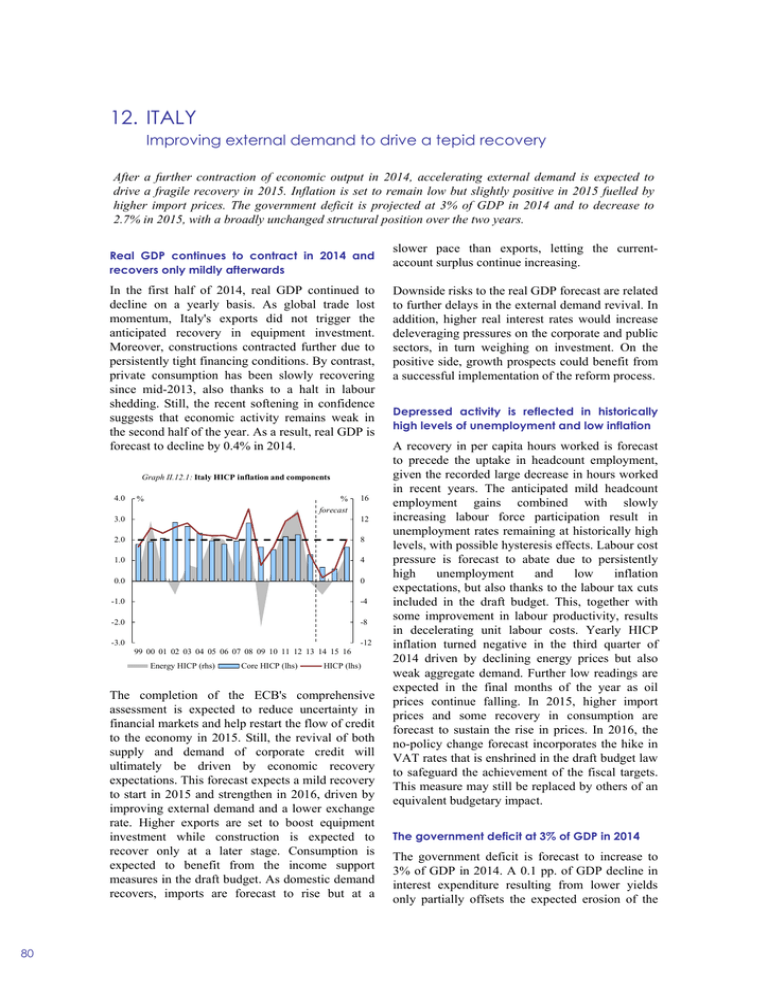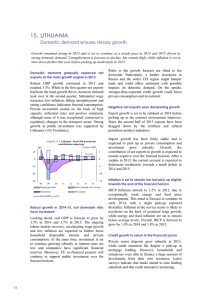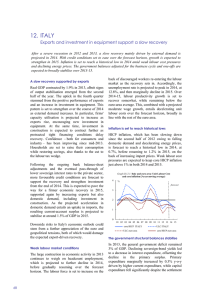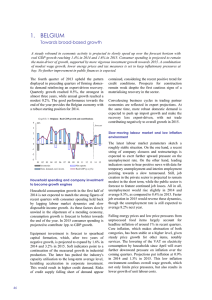Italy
advertisement

12. ITALY Improving external demand to drive a tepid recovery After a further contraction of economic output in 2014, accelerating external demand is expected to drive a fragile recovery in 2015. Inflation is set to remain low but slightly positive in 2015 fuelled by higher import prices. The government deficit is projected at 3% of GDP in 2014 and to decrease to 2.7% in 2015, with a broadly unchanged structural position over the two years. Real GDP continues to contract in 2014 and recovers only mildly afterwards In the first half of 2014, real GDP continued to decline on a yearly basis. As global trade lost momentum, Italy's exports did not trigger the anticipated recovery in equipment investment. Moreover, constructions contracted further due to persistently tight financing conditions. By contrast, private consumption has been slowly recovering since mid-2013, also thanks to a halt in labour shedding. Still, the recent softening in confidence suggests that economic activity remains weak in the second half of the year. As a result, real GDP is forecast to decline by 0.4% in 2014. Graph II.12.1: Italy HICP inflation and components 4.0 % % forecast 16 3.0 12 2.0 8 1.0 4 0.0 0 -1.0 -4 -2.0 -8 -12 -3.0 99 00 01 02 03 04 05 06 07 08 09 10 11 12 13 14 15 16 Energy HICP (rhs) Core HICP (lhs) HICP (lhs) The completion of the ECB's comprehensive assessment is expected to reduce uncertainty in financial markets and help restart the flow of credit to the economy in 2015. Still, the revival of both supply and demand of corporate credit will ultimately be driven by economic recovery expectations. This forecast expects a mild recovery to start in 2015 and strengthen in 2016, driven by improving external demand and a lower exchange rate. Higher exports are set to boost equipment investment while construction is expected to recover only at a later stage. Consumption is expected to benefit from the income support measures in the draft budget. As domestic demand recovers, imports are forecast to rise but at a 80 slower pace than exports, letting the currentaccount surplus continue increasing. Downside risks to the real GDP forecast are related to further delays in the external demand revival. In addition, higher real interest rates would increase deleveraging pressures on the corporate and public sectors, in turn weighing on investment. On the positive side, growth prospects could benefit from a successful implementation of the reform process. Depressed activity is reflected in historically high levels of unemployment and low inflation A recovery in per capita hours worked is forecast to precede the uptake in headcount employment, given the recorded large decrease in hours worked in recent years. The anticipated mild headcount employment gains combined with slowly increasing labour force participation result in unemployment rates remaining at historically high levels, with possible hysteresis effects. Labour cost pressure is forecast to abate due to persistently high unemployment and low inflation expectations, but also thanks to the labour tax cuts included in the draft budget. This, together with some improvement in labour productivity, results in decelerating unit labour costs. Yearly HICP inflation turned negative in the third quarter of 2014 driven by declining energy prices but also weak aggregate demand. Further low readings are expected in the final months of the year as oil prices continue falling. In 2015, higher import prices and some recovery in consumption are forecast to sustain the rise in prices. In 2016, the no-policy change forecast incorporates the hike in VAT rates that is enshrined in the draft budget law to safeguard the achievement of the fiscal targets. This measure may still be replaced by others of an equivalent budgetary impact. The government deficit at 3% of GDP in 2014 The government deficit is forecast to increase to 3% of GDP in 2014. A 0.1 pp. of GDP decline in interest expenditure resulting from lower yields only partially offsets the expected erosion of the Member States, Italy primary surplus. Primary expenditure is projected to increase in nominal terms by 1% year-on-year, also driven by support measures to low-wage employees, while the recognition of sizeable tax credits of banks related to past losses (Deferred Tax Assets) weighs on capital expenditure. Revenues are expected to increase marginally relative to 2013, thanks to higher intakes from VAT and property taxation that compensate for a fall in corporate income taxes. In 2015, after incorporating the draft budget and the additional measures announced on 27 October, the deficit is projected at 2.7% of GDP, again supported by declining interest expenditure. In nominal terms, primary expenditure is set to rise slightly. The planned expenditure savings affect both capital and current expenditure, but the latter is set to increase mainly driven by the confirmation of the income support measure and the extended coverage of unemployment benefits, while public wages remain frozen. Despite a further cut to the labour tax wedge, tax revenues are set to increase mainly due to a recovery in corporate income taxes and higher withholding taxes on financial income. In 2016, under the no-policy change assumption, the deficit is forecast to narrow to 2.2% of GDP. The VAT hike is set to contribute to the expected rise in the primary balance. The structural balance is set to broadly stabilise in 2014 and 2015. Graph II.12.2: Italy - Public finances 140 % of GDP % of GDP 7.0 120 6.0 100 5.0 80 4.0 60 3.0 40 2.0 20 1.0 forecast 0.0 0 03 04 05 06 07 08 09 10 11 12 13 14 15 16 General government debt (lhs) General government deficit (rhs) The 2013 debt-to-GDP ratio has been revised downward by 4.7 pps., to 127.9%, due to the switch to ESA2010. The expected primary surplus is still insufficient to curb the growth of the debt ratio in 2014, due to flat nominal growth and the settlement of trade debt arrears. The debt ratio is set to peak in 2015, despite privatisation proceeds of 0.5% of GDP, and decline in 2016 thanks to the higher nominal growth and primary surplus. Table II.12.1: Main features of country forecast - ITALY 2013 GDP Private Consumption Public Consumption Gross fixed capital formation of which: equipment Exports (goods and services) Imports (goods and services) GNI (GDP deflator) Contribution to GDP growth: Annual percentage change bn EUR Curr. prices % GDP 95-10 2011 2012 2013 2014 2015 1618.9 100.0 1.0 0.6 -2.3 -1.9 -0.4 0.6 1.1 979.4 60.5 1.2 0.0 -4.0 -2.8 0.2 0.4 0.0 314.8 19.4 0.9 -1.8 -1.5 -0.7 -0.9 -0.3 0.9 288.6 17.8 1.6 -1.9 -7.4 -5.4 -2.5 1.4 3.1 93.8 5.8 2.4 0.2 -11.3 -4.8 -2.1 2.7 5.4 462.3 28.6 2.6 5.2 2.0 0.6 1.5 3.4 4.2 425.4 26.3 3.8 0.5 -8.0 -2.7 1.3 2.7 3.5 1616.1 99.8 1.1 0.5 -2.2 -1.9 -0.3 0.6 1.1 1.2 -0.8 -4.2 -2.9 -0.5 0.4 0.7 0.0 0.2 -0.9 0.0 0.1 0.0 0.1 -0.2 1.2 2.8 0.9 0.1 0.3 0.3 0.4 0.1 -0.9 -1.7 -0.4 0.2 0.6 9.0 8.4 10.7 12.2 12.6 12.6 12.4 3.1 1.1 0.9 1.2 0.8 0.6 1.0 2.5 0.7 2.3 1.4 0.8 0.2 0.5 -0.1 -0.8 0.6 0.0 0.4 -0.3 -1.0 15.1 10.6 10.4 11.7 11.8 12.3 12.6 2.6 1.5 1.6 1.4 0.4 0.5 1.5 2.5 2.9 3.3 1.3 0.2 0.5 2.0 -0.3 -3.4 -1.4 2.0 2.2 -0.3 -0.1 Domestic demand Inventories Net exports Employment Unemployment rate (a) Compensation of employees / f.t.e. Unit labour costs whole economy Real unit labour cost Saving rate of households (b) GDP deflator Harmonised index of consumer prices Terms of trade goods Trade balance (goods) (c) Current-account balance (c) Net lending (+) or borrowing (-) vis-a-vis ROW (c) General government balance (c) Cyclically-adjusted budget balance (c) Structural budget balance (c) General government gross debt (c) 2016 1.1 -1.1 1.0 2.3 2.8 3.0 3.2 -0.3 -3.1 -0.5 1.0 1.5 1.5 1.8 -0.2 -3.0 -0.2 1.0 1.6 1.7 1.9 -3.6 -3.5 -3.0 -2.8 -3.0 -2.7 -2.2 -1.1 -3.8 -2.6 -1.5 -0.6 - -0.6 -0.9 - -3.3 -1.6 -0.8 - -0.9 -0.8 -1.0 107.1 116.4 122.2 132.2 133.8 132.7 127.9 (a) Eurostat definition. (b) gross saving divided by gross disposable income. (c) as a percentage of GDP. 81









